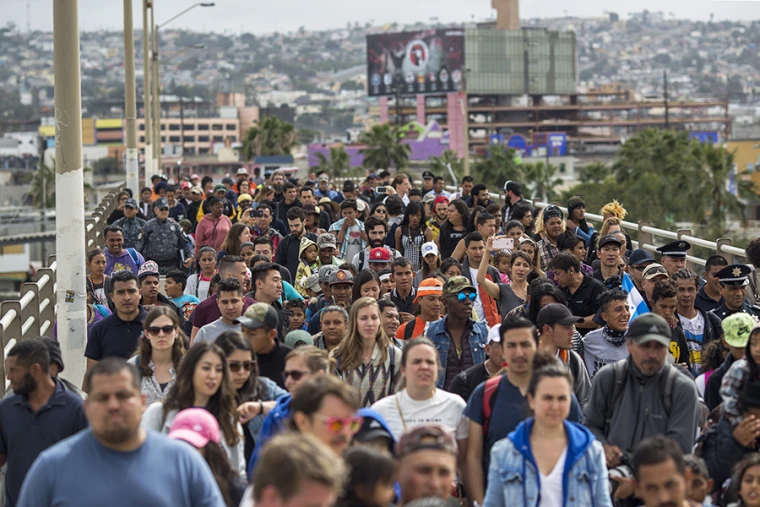
It wasn’t hard to predict, but even so it’s worth the effort to repeat what I pointed out here on Nov. 14, almost two weeks ago: Because of the Trump administration’s refusal to allow the Central American caravans to enter as a group, they are stuck at the northern border.
That blog post was titled “Limbo at the Border.”
For weeks the Mexican federal authorities, in the face of the Central American exodus, have fluctuated between an inability to enforce the law and the fear of angering the politically correct, who demand that everyone that wants to come to the United States should be allowed to enter.
The results are there for all to see: Since October, thousands of people, whose identities and intentions are unknown, have entered Mexican territory.
I would not dare to assert – as Trump and his secretary of Homeland Security have done – that there are hundreds of criminals among the more than 8,000 Central Americans that have entered Mexico as a group. The only thing that is certain is that who they are and whether they have violated the law in their passage through the country is unknown.
Saying that is a simple statement of fact; it does not imply taking a position against immigration. I personally believe that a country is enriched when people from other nations, who wish to contribute to the country’s development, are welcomed in. But this must always take place in an orderly way and with a clear purpose.
Nor is it xenophobic to assert that the arrival and transit of foreigners in the country has to be governed by rules. Otherwise their safety, and the safety of residents, could be put at risk.
Today in Baja California there are more than 8,000 immigrants that arrived together in a caravan. The overwhelming majority of them are here in Tijuana.
According to the municipal authorities, their stay is costing the city 500,000 Mexican pesos a day [approximately $25,000]. I have not been able to verify this figure, but it sounds reasonable and is perhaps underestimated. This comes out to 62 pesos per person per day [about $3.00].
A half million pesos a day is a considerable amount for the municipal budget. In six weeks, taking care of these immigrants will add up to the equivalent of the budget for health, 95,000,000 pesos in 2018 [about $4.7 million]. Now, think if it becomes double or triple that.
Political correctness does not take into account the financial cost, which is not paid by the government, but by the taxpayers.
When this immigration crisis started, the president-elect, Andrés Manuel López Obrador, offered to provide a million work visas for Central American immigrants when he takes office.
If he decides to keep this promise, it would be expected that the problem caused by the presence of 8,000 immigrants will be multiplied several times.
The Mexican government can decide that it doesn’t want scenes of Central Americans crowding Mexico’s southern border, and that the way to avoid that is to let them in. What it cannot decide is to let them enter the United States. So, the government will have to decide where it wants them to be seen: in Tecún Umán, Guatemala, or here in Tijuana, Baja California, Mexico.
No country alone can deal with the current immigration issue. Multilateral action will be required. There is no nation in the world, however large or powerful it may be, that can accept everybody who wants to become a part of it. The obligation to accept some and reject others is a necessary imposition. Each country has to establish its own criteria.
Former President Barack Obama, who is viewed very positively in Mexico, was the U.S. president that deported the most people. Even so, he did create the “Dreamers” program, giving priority to those that arrived as infants.*
Once again, saying that a country has to decide whom to let in and whom to turn away doesn’t imply that it doesn’t have compassion or that it is xenophobic. It’s just a question of being honest and taking everything into account.
Thirty-two million people live in the so-called Northern Triangle of Central America. Let’s suppose that 10 percent of them want to go to the U.S. and want to go through Mexican territory to get there.
Because it is not a country with unlimited resources, Mexico must manage immigration. It can’t let everyone who wants to use its territory as a transit route pass through without restrictions or regulations.
If the U.S. were willing to let in everybody that wants to enter the country, it wouldn’t be such a problem. But the scenes at the border in recent days are forcing authoritie to bring order to the country’s entrance.
Controlling immigration at our border is not doing Donald Trump’s dirty work. Rather, it is avoiding serious consequences to a country that itself already has many shortcomings to address.
*Editor’s note: The Development, Relief and Education for Alien Minors or DREAM act is congressional legislation that would allow young immigrants in the country illegally who were brought here as children to remain in the country if they meet certain criteria. These children are referred to as “Dreamers.” As of the publication of this article, the legislation has not been approved by Congress.

Leave a Reply
You must be logged in to post a comment.